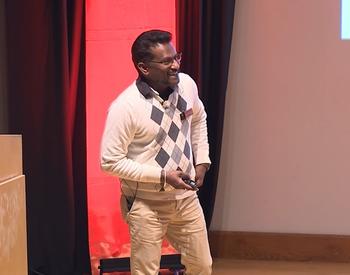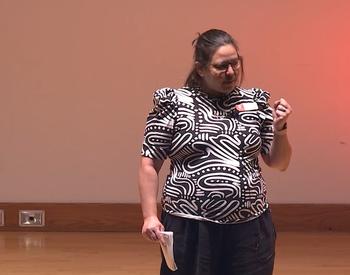CORVALLIS, Ore. – At Oak Creek Center for Urban Horticulture trees along the creek show signs of beavers gnawing. A doe and her fawn nibble greenery. Skunks, raccoons and even a gray fox feel at home. Birds, including a red-tailed hawk, find plenty of sustenance and shelter.
Al Shay, manager of the center along with site manager Cody Buckman, works with a small retinue of students to keep the center wildlife friendly. Their efforts recently garnered the center Certified Wildlife Habitat status by the National Wildlife Federation.
As the group continues its commitment to environmental sustainability, birds find a haven at the center. They flock to the long hedgerow of diverse shrubs and trees, many with fruit, seeds, berries and all the insects they can eat. There’s water from the creek and shelter in trees and shrubs throughout the 6.5-acre site at the southwest edge of the Corvallis campus.
As a favor, Shay asked Bill Proebsting, an experienced birder and professor emeritus of horticulture at OSU, to survey the birds at Oak Creek. In early October, Proebsting started visiting once or twice a week to do a 20-minute circuit of the property. By December, he’d counted 47 different birds. Whatever species he spots gets entered into the eBird data base maintained by Cornell University Lab of Ornithology, a worldwide website where citizen scientists can enter the birds they spot. The information is used to inform research, conservation and education.
“It’s the big picture of what’s happening to birds,” Proebsting said. “With climate change, you get all these species moving north, moving uphill. The habitat is changing. Birds are declining. This is useful data.”
Proebsting, who topped 2,500 bird sightings during his 10th trip to Bolivia, said Cornell is trying to obtain a massive amount of information. Biologists and other researchers can test different hypothesis about habitat or seasonal movement.
During the seven trips he’s taken to the Oak Creek center so far, Proebsting has seen mostly common birds but in high numbers.
“It’s a good location for juncos, finches, chickadees, sparrows, crows, starlings,” he said. “I’ve also seen a great blue heron and uncommon white-throated sparrows and Hutton’s vireo. It will change over the course of a year, so I’ll do it at least a year.”
For someone who’s been birding 41 years, the 47 species at Oak Creek may not seem overly impressive, but to Shay it’s an accomplishment. The goal is to attract wildlife, and the growing number of birds is an indication that the efforts are working.
“It reflects habitat,” said Proebsting, who goes birding every day. “There’s riparian, weedy patches, hedges of mostly native plants, rototilled areas that birds love, crops with seeds. It’s a good solid place for basic birds.”
Proebsting and Shay agree that habitat must be appropriate to draw birds. People need to come together to help solve the problem. Locally, they point to a small movement to add more bird-loving areas around farms.
“Some agriculturists and environmentalists make the case that we could farm in a way that gives up a little productivity but offers good habitat for wildlife,” Proebsting said. “Is there a different way to do agriculture? We’re trying to reduce the decline.”
The efforts are critical, Shay said. A recent study published in the journal Science shows that the number of birds in the U.S. and Canada has declined by 3 billion or 28 percent over the past 50 years. Oak Creek Center for Urban Horticulture may be only 6.5 acres, but, as Shay puts it, “We have to start somewhere. We can’t just keep talking. We have to act.”


















